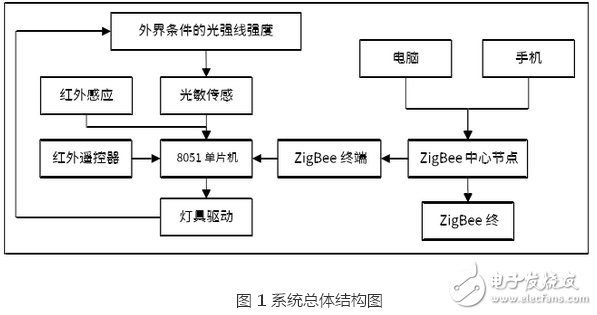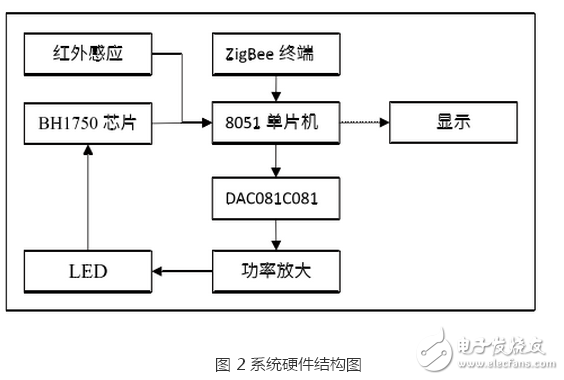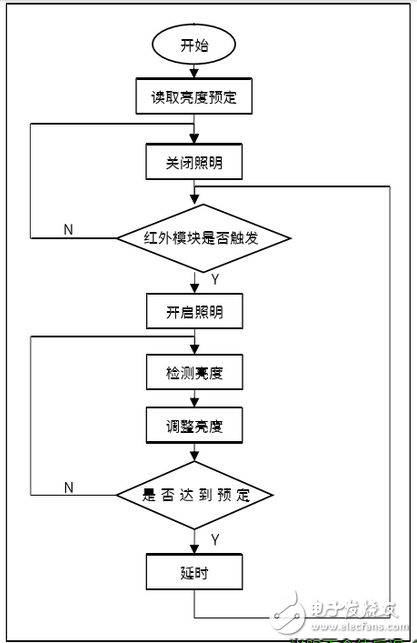According to relevant statistics, the electricity consumption of office lighting accounts for about 30% of the energy consumption of the entire building. The equipment cost of office lighting (including lighting equipment and wiring engineering costs) accounts for more than 10% of the electrical engineering costs, so choose a reasonable one. The lighting scheme and the advanced control system can not only greatly simplify the workload of the pipe-wiring, but also effectively save energy, reduce user operating costs, and improve the management level of the building, which has great economic and social benefits.
The existing intelligent lighting system on the market can only control the lighting switch, and can not automatically compensate for the appropriate brightness according to the ambient illumination. Therefore, this paper designs a zigbee-based brightness grading intelligent lighting system, which automatically adjusts the brightness of the lighting device by sensing the intensity of the illuminance in the area to achieve comfort, practicality, energy saving and environmental protection.
Design plan and working principle
To achieve the goal of this design, first of all, the system needs to be able to detect the illumination of the environment. Here, the commonly used photosensitive element contrast is used for detection. Secondly, the system can compensate for the environment with insufficient contrast. Here, the white light led with convenient control and high efficiency is used. Then, use infrared sensing to detect if someone is in need of lighting. Finally, the zigbee protocol is used to make all the lighting devices form a network for easy control. The system design and working principle are shown in Figure 1. The core of the whole system is zigbee. zigbee is a low-power LAN protocol based on IEEE802.15.4 standard. It is mainly suitable for automatic control and remote control. It can be embedded in various devices and is a cheap, low-power short-range wireless. Network communication technology. The use of zigbee here mainly considers the extension of the intelligent lighting system in other aspects, such as the latest technology trend of the Internet of Things, so that this system is not only an intelligent lighting system, but also becomes an IoT system after adding the program. On the periphery, the detection and control of brightness are all done by independent MCUs, which allows the zigbee terminal to use more CPU time, such as real-time monitoring, infrared sensors, and photo sensors.

The plan is as follows:
1. When someone approaches, the infrared module detects that someone has passed, and then turns on the illumination. After a certain time delay, no one is detected to pass, then turning off the illumination can save energy;
2. When the light source is illuminated, the photosensitive element is used to detect the brightness of the surrounding environment, and the brightness is fed back to the single chip microcomputer, and the single chip compares the data with the preset data, and then adjusts the brightness of the light source to a predetermined value. . (The predetermined value here can be set manually.) In terms of lamp brightness control, constant voltage drive is used to change the brightness by changing the voltage.
System hardware design
The system hardware is mainly composed of 12864 liquid crystal, BH1750 chip, pyroelectric infrared sensor, DAC081C081 chip, STC89C52 single chip microcomputer, class B power amplifier circuit and zigbee wireless transmission unit. The system hardware structure is shown in Figure 2. A closed loop adjustment system is used here to increase the speed of brightness adjustment. First, the BH1750 chip converts the illuminance into a digital quantity and transmits it to the MCU. After processing the data, the MCU displays the current illuminance value with 12864 liquid crystal, and then uses DA conversion to output different voltages to drive the LED. Increasing or decreasing the voltage to control the enhancement and attenuation of the brightness of the LED, and then detecting the ambient brightness again, repeat the above steps until the detected brightness tends to the illuminance value set by the infrared remote control, and finally the ambient brightness tends to be reasonable.

The various components are introduced: 12864 is a liquid crystal screen with a total of 128x64 points to display the currently detected illuminance value or setting interface. The BH1750 is a 16-bit digital output ambient light intensity sensor with high accuracy and high sensitivity for illuminance detection. The pyroelectric infrared sensor is an infrared sensor that is particularly sensitive to human infrared radiation and is used to detect if someone has passed. STC89C52 MCU is a 51-compatible MCU, which is more common and cost-effective. The DAC081C081 is an 8-bit low-power DAC that works in conjunction with a Class B power amplifier circuit as the driver stage for the LED. The zigbee wireless transmission unit is the total control terminal for controlling whether the lighting system works. When the daytime, the whole system is turned off to save power. When it is at dusk, the system is automatically turned on and the intelligent lighting system starts to work.
System software design
The system's software is in C language. It is widely used, does not require a complicated program setting environment, supports a variety of programming styles such as procedural programming, data abstraction object-oriented programming, generic programming, etc. The language is very flexible, the function is quite powerful, and the level of grammar Distinct and echoing. For future updates, maintenance and expansion, modular thinking is used in the design process.

Figure 3 is the system flow chart
First, a value will be predetermined as a reference value for illuminance. Since the device is just turned on, the lighting device is turned off, and then infrared sensing is continuously performed. When someone passes, the infrared sensing module is triggered, and the illumination is turned on, the brightness is detected, the control voltage is increased or decreased, and then the predetermined value is detected. Until the predetermined value is reached. Delay the preset time, wait for the pedestrian to pass, and then detect the infrared sensor again. When there are still people, since the lighting has been turned on, the next step is continued; when there is no one, the lighting device is turned off and the infrared detection is continued, waiting for the next person to pass.
Conclusion
The system designed in this paper has been used to test the brightness grading controller of a certain kind of luminaire. The practical application shows that the system is accurate, stable and reliable. The intelligent lighting luminaire produced according to this system has the advantages of sensitive response and soft lighting. If the LED drive mode is changed to a constant current switching power supply, the efficiency of the system will be further improved. Led is a current-type device. The current is more effective in controlling the brightness of the LED. Since only the duty cycle of the PWM wave needs to be changed, the current can be changed, which is convenient, and the switching power supply has high efficiency and low temperature. However, this scheme has large electromagnetic radiation and requires reasonable design to avoid interference and electromagnetic radiation.
Resistive Touch Screen
The outermost layer of resistance screens is usually a soft screen that connects the internal contacts up and down by pressing. The inner layer contains the oxidized metal of the physical material, namely N-type oxide semiconductor (indium oxide), also known as indium oxide, with an optical transmittance of 80% and the upper and lower layers separated by the middle. ITO is the main material used in both resistive and capacitive touch screens. Their working surface is the ITO coating. The outer layer is pressed by fingertips or any object to make the surface film concave and deformed. According to the leading line number of screen, divide again have 4 line, 5 line and much line, threshold is low, cost is opposite cheap, advantage is not affected by dust, temperature, humidity. Disadvantages are also obvious, the outer screen film is easy to scratch, can not use sharp objects to touch the surface. In general, multi-touch control is not allowed, that is, it can only support a single point. If two or more contacts are pressed at the same time, they cannot be recognized and accurate coordinates can be found. To enlarge a picture on the resistance screen, you can only click "+" several times to make the picture be enlarged step by step. This is the basic technical principle of the resistance screen.
Control by pressure induction. When a finger touches the screen, the two conductive layers are in contact at the touch point and the resistance changes. A signal is generated in both X and Y directions and transmitted to the touch screen controller. The controller detects the contact and calculates the position of (X, Y), then works according to the simulated mouse mode. Resistive touch screen is not afraid of dust, water and dirt, and can work in harsh environments. But because the outer layer of the composite film is made of plastic material, its anti-explosion property is poor, and its service life is affected to some extent.
The resistive touch screen is controlled by pressure induction. The surface layer is a layer of plastic and the bottom layer is a layer of glass, which can withstand the interference of harsh environmental factors. However, it has poor hand feel and light transmittance, so it is suitable for wearing gloves and occasions that cannot be touched directly by hand.
Resistive Touchscreen,Resistive Screen,Resistive Touch,Resistive Touch Panel
Tonya Display Limited , https://www.tydisplay.com